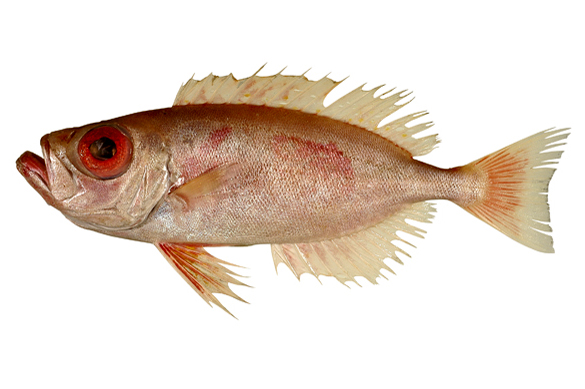Deepsea Bigeye, Priacanthus fitchi Starnes 1988
Other Names: Whitefin Bigeye

Deepsea Bigeye, Priacanthus fitchi. Source: Australian National Fish Collection, CSIRO. License: CC BY Attribution-Noncommercial
Summary:
A slender silvery pink to reddish bigeye with a red iris, a long, narrow preopercular spine, soft portions of dorsal and anal fins with creamy-white rays posteriorly, and yellowish pelvic fins.
Cite this page as:
Bray, D.J. 2022, Priacanthus fitchi in Fishes of Australia, accessed 25 Apr 2024, https://fishesofaustralia.net.au/Home/species/1834
Deepsea Bigeye, Priacanthus fitchi Starnes 1988
More Info
|
Distribution |
North West Shelf, Western Australia. Elsewhere the species occurs in the tropical Indo-west Pacific: Indonesia east to the Philippines, north to southern Japan, south to northern Australia. Inhabits relatively open areas in deeper waters on the continental shelf and upper slope. |
|
Features |
Dorsal fin X,13; Anal fin III,13-14; Pectoral fin 18-19; Gill rakers 4-5 + 18-20 = 22-25; Scales in lateral series 77-87; Lateral-line scales 74-79; Vertical scale rows 45-51, 8-10 above lateral-line, 36-41 below . Body oval, usually tapering considerably from behind head to below middle of soft dorsal fin; eye very large; preopercular spine well developed, usually reaching to or well beyond opercular margin at all sizes. Caudal fin truncate or very slightly concave. Soft portions of dorsal and anal fins broadly rounded, of moderate length, subequal to eye diameter. Pectoral fins relatively long and pointed, usually exceeding length of pelvic spines. Pelvic fins not reaching first anal spine except in large specimens. |
|
Fisheries |
Taken in demersal trawls on the North West Shelf, Western Australia. |
|
Similar Species |
Differs from Priacanthus blochii and P. hamrur in usually having a well developed preopercular spine at all sizes and lacking a black basal spot on the dorsal surfaces of pelvic fins.Differs from P. tayenus in lacking inky black spots on pelvic fin membranes, having rounded (vs. more pointed) soft portions of the dorsal and anal fins, and higher scale counts (LS = 77-87 vs. 56-73).Distinguished from the more similar P. macracanthus in lacking spots on fin membranes, having creamy white soft dorsal and anal fins, a slender, more tapered body, and generally a larger eye. |
|
Etymology |
The species is named in honour of the late John E. Fitch, marine and fisheries biologist, California Department of Fish and Game, “whom I never had the privilege of meeting, but with whom I exchanged much valuable information on priacanthid systematics prior to his death. His contributions to ichthyology, and especially to our knowledge of otolith morphology, are considerable.” |
|
Species Citation |
Priacanthus fitchi Starnes 1988, Bulletin of Marine Science 43(2): 164, fig. 3e, pl. 1h. Type locality: Sumatra, 0°25'S, 98°40'E, Indonesia, depth 150 m. |
|
Author |
Bray, D.J. 2022 |
|
Resources |
Deepsea Bigeye, Priacanthus fitchi Starnes 1988
References
Allen, G.R. 1997. Marine Fishes of Tropical Australia and South-east Asia. Perth : Western Australian Museum 292 pp. 106 pls.
Gloerfelt-Tarp, T. & Kailola, P.J. 1984. Trawled Fishes of Southern Indonesia and Northwest Australia. Jakarta : Dir. Gen. Fish. (Indonesia), German Tech. Coop., Aust. Dev. Ass. Bur. 406 pp.
Sainsbury, K.J., Kailola, P.J. & Leyland, G.G. 1984. Continental Shelf Fishes of Northern and North-Western Australia. Canberra : Fisheries Information Service 375 pp. figs & pls.
Starnes, W.C. 1988. Revision, phylogeny and biogeographic comments on the circumtropical marine percoid fish family Priacanthidae. Bulletin of Marine Science 43(2): 117-203 See ref online
Starnes, W.C. 1999. Family Priacanthidae. pp. 2590-2601 in Carpenter, K.E. & Niem, T.H. (eds). The Living Marine Resources of the Western Central Pacific. FAO Species Identification Guide for Fisheries Purposes. Rome : FAO Vol. 4 pp. 2069-2790.

